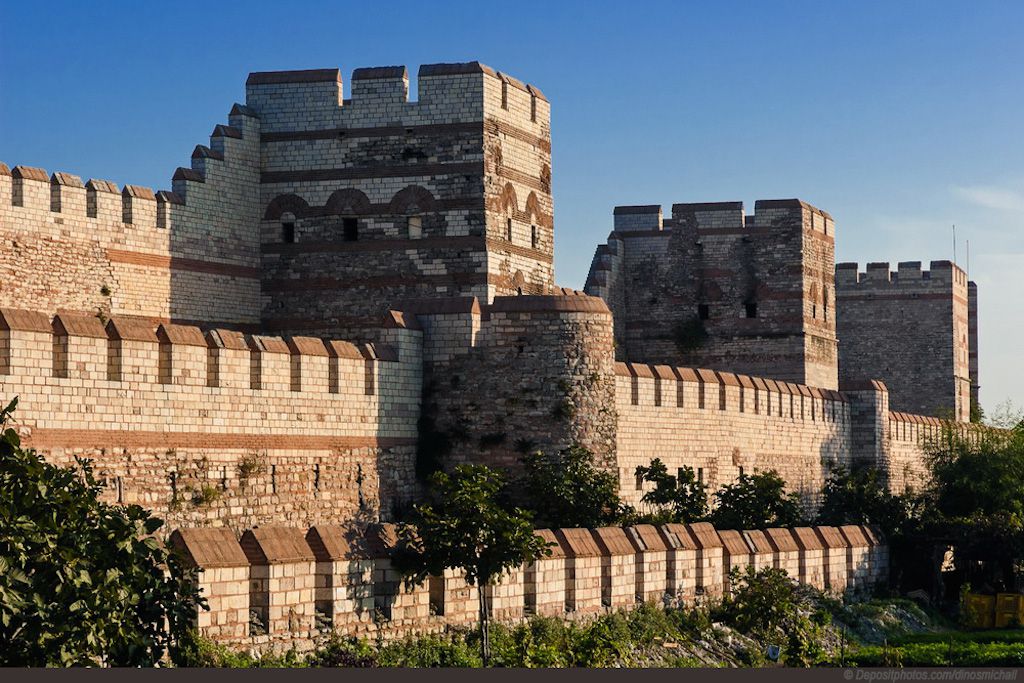
Byzantine City Walls
Istanbul Walls are city walls built around Byzantine time around Istanbul. The city walls around Istanbul were built in the 7th century, and they were destroyed and rebuilt four times.
It’s after the final construction of MS 408. II. During the time of Theodosius (408-450), the city walls of Istanbul stretched along the Golden Horn coast from Ayvansaray on this side, along the Marmara coast to Yedikule, from Yedikule to Topkapi, and from Topkapi to Ayvansaray.
History
The Emperor in the Making II. Theodosius Praefaectus was started by Anthemios in 413. The only force that can cross the walls of Istanbul II. Mehmet is the leader of the leadership. Praefactus Konstantinus Kyros had a second wall in front of the Sura at a time when the Huns of Atilla threatened the city.
The towers of number 96 were constructed differently. 74 of them are square, one is pentagon, 5 is hexagon, 2 is seventh, and 14 is eight. The tops of the towers are covered with vaulted floors. As it is also in the Iznik walls, the walls of these upstairs rooms feature previously painted Aziz paintings in fresco technique. The length of the towers is not the same everywhere. A few meters of difference can be seen from Marmara to Tekfur Palace.
There are many gates opening out on the land side walls. Some of these were gates of people entering and leaving and they were closed in danger. In the second period, there were some important military gates. The most important of these doors is the Golden or Gilded Gate which was also used as the beginning of the Victory Road.
The bastion, the wall, and the inscriptions on the doors write the history of the wall.
It is the fortified walls surrounding the greatest cause of Istanbul being a legendary city that can not be conquered for a long time. There was no such a solid defense system anywhere else at the time. Even though it was inaccessible in terms of length, the Chinese Great Wall could not approach the walls of Istanbul for defense.
6492 m on the land The 820 m long walls on the shores of Marmara and Golden Horn are composed of several stages. At the forefront, Byzantine defended mobile forces, with 20 m wide and 7.5 m deep ditches filled with water. Behind them were defensive troops waiting for the spearmen. If the defenses were passed, they reached the fortified walls of 5-7 m high. The Ottoman Army had lost a lot in front of the central city walls. At the rear, the main walls were 12-13 m high. The soldiers waiting on the main city walls would not allow any creature to approach the city wall.
The length of the walls is 22 km. The Golden Horn walls are 5.5 km, the land walls 7.5 km. Marmara Walls are 9 km.
The land walls consist of three parts. Ditch, outer wall, inner wall. The ditches have become agricultural land today. Adjacent and 50 m. On the side of the land walls, there are 96 bastions, many of which have been demolished and cracked. These signs are located on a 10 m ledge from the walls extending from the wall, mostly square and 25 m. In height.
There are windows, vaults, doors. There are doors and stairs between inner walls and outer walls. Inside walls and bastions were used stone and bricks. The outside walls are the entrance to the chest. On the outer walls there are small signs to come between the smaller and larger signs. All these ditches, bastions, outer and inner walls have a total width of 70 m. The walls have corrugations and small cavities.
There is a moat and an outer wall before the Marmara and Halic walls. These walls are 5 m in height and 15 m in height. The signs are 20 meters long, 103 on the Marmara side and 94 on the Golden Horn. The Suburban Train is working along the Marmara side walls.
Some of them have historical fame: Yedikule, Sulukule, Anemas, Isaakios, Mermerkule, Arapkule. Most of them were used as dungeons, prisons, mints.
DOORS
There are main buildings and yankapis along the walls of Istanbul. The doors are 5 m. It is under a wide belt. The gates outside the Topkapi and Edirnekapi, which are crossed by the main roads, are as tall as two cars can not pass by side by side.
These doors had marble-clad interiors, wooden doors. The stairs built to climb onto the wall are on the inside of the doors on the right and on the left. In the spaces inside the door walls, there were demirkapi or bars used to close the main house. In addition, some of the motherboards had an outer door. Many of them have disappeared in history. There are inscriptions on some of the gates, but they are from the Ottomans. 25 meters from the outer door to the inner door.
Starting from the Topkapı Palace gate, to the Golden Horn, from here to Yedikule and back to the Topkapı Palace, the doors of the walls are like this:
– Topkapisarayı kapısı
– Ahırkapı
– Fenerity
– Kucukayasofyakapısı
– Bukalonkapı
– Fishhook
– Odunapapısı
– Manganakapısı
– Gulhanekapısı
– Kadırgakapısı
– Cracked
– Kumkapi
– Yenikapi
– Samatyakapısı
– Narcissus
– Yedikulekapi
– BelgradKapi
– Silivrikapi
– Relocation
– Topcap
– Edirnekapı
– Egriakapi
– Ayvansaray kapısısı
– Atikmustafakapısı
– Balatpa
– Fenerkapısı
– NewYakapi
– Footwear
– Cibalikapısı
– Unkapanapısı
– Ayazmakapısı
– Odunapapısı
– Fish marketplace
– Yenicamikapısı
– Garden door
– Hunters
– Idiot doctor
– Zindankapısı
– Sirkecikapi
– Yaliskaki
There are 50 doors and 300 bastions on the walls of Istanbul and some are missing. There were also gates to the fortifications on the outer city Galata side: Kurşunlumahzen, Karaköy, Balıkpazarı, Yağkapanı, Kürkçükapı, Azapkapı.













